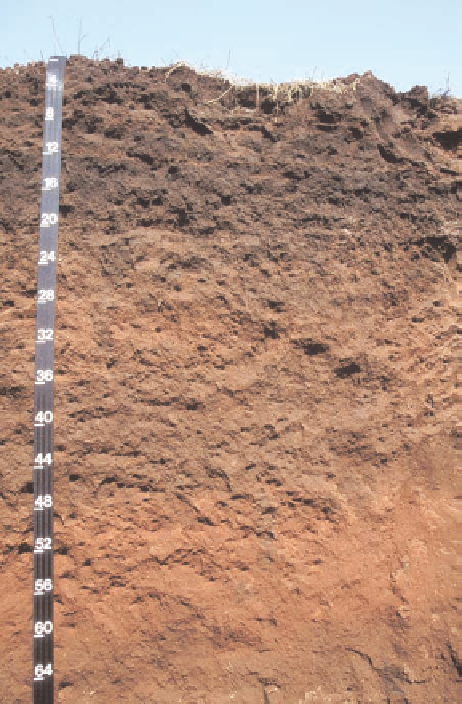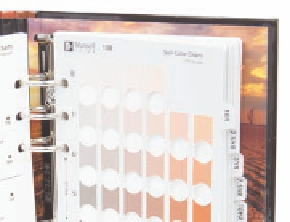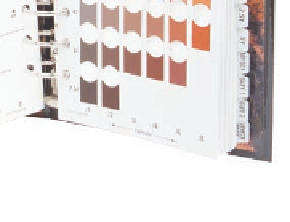Geoscience Reference
In-Depth Information
2.
Some pedogenic processes cause physical changes to
occur within the soil, whereas others cause soil compo-
nents to move within the soil.
individually, remember that all work together to give any one soil
a particular overall character.
1.
Color
Soils vary considerably with respect to color, both
within and between soils. Color can be an indicator of
the composition of the soil. For example, soils with dark
colors usually have high humus or organic matter content
(Figure 11.13a), which might indicate that the biomass of
the region is high or that the environment is cool and wet
or that organic matter decomposes slowly. Soils with a
high content of iron-bearing minerals are often a reddish
color, whereas soils (or parts of soils) that contain abundant
calcium are whitish in color. These colors might reflect the
color of the local parent material, or they may indicate the
amount and type of eluviation that has occurred over time.
3.
Pedogenic processes occur within the context of five
soil-forming factors: parent material, climate, organ-
isms, relief, and time.
4.
Each soil-forming factor contributes to all soil develop-
ment in some way.
Measurable Soil Characteristics
To understand soil formation thoroughly, remember that the
soil-forming factors just discussed are individual parts of a holistic
system in the sense that each contributes something to the devel-
opment of any particular soil. As a soil forms under a particular
set of environmental conditions, it develops properties that are
unique to that particular setting. By using people as an analogy,
it becomes clear that each person whom you know has different
characteristics that you can readily identify, such as brown hair,
blue eyes, and height. With respect to soils, the properties are
physical characteristics that can be measured to distinguish dif-
ferent soils from one another. By examining the physical proper-
ties of a soil, it is possible to learn something about how the soil
formed. These properties are color, texture, structure, soil chemis-
try, and soil pH. Although these properties will now be discussed
Soil color is typically measured with a Munsell Color
Chart (Figure 11.13b). This color-system uses three elements of
color—hue, value, and chroma—to designate a specific color.
Hue
is a measure of the chromatic composition of light that
reaches the eye. The Munsell system is based on five principal
hues: red (R), yellow (Y), green (G), blue (B), and purple (P).
In addition, five intermediate hues represent midpoints between
each pair of principal hues, resulting in ten major hue names.
The intermediate hues are yellow-red (YR), green-yellow (GY),
blue-green (BG), purple-blue (PB), and red-purple (RP).
Value
indicates the degree of lightness or darkness of a color in rela-
tion to a neutral gray scale under natural lighting, ranging
(b)
Figure 11.13 Differences in soil color.
(a) The lower part of
this soil in Oklahoma is red because it formed in residual parent
material (regolith) derived from iron-rich bedrock. In contrast, the
upper part of the soil is relatively dark because of the addition of
humus to the parent material. In other words, all the parent mate-
rial was reddish at one time, but the upper part was transformed
to a darker color through the addition process. (b) Soil color is
measured with a Munsell Color Chart that specifies hue, value,
and chroma.
(a)





